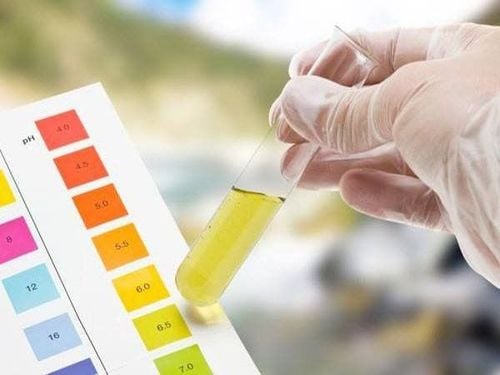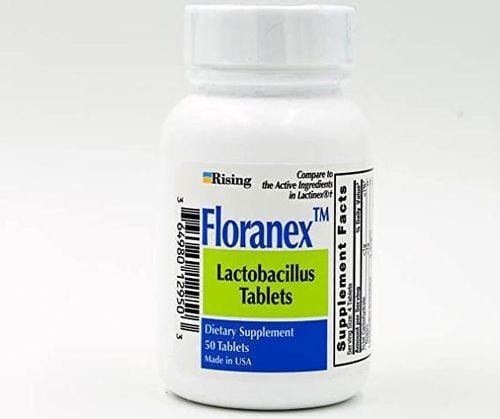This is an automatically translated article.
The article was professionally consulted by a doctor of Obstetrics and Gynecology, Vinmec Central Park International General Hospital.Among the 10-parameter urine test results of pregnant women, the protein in the urine is of most interest because this is one of the manifestations of pregnancy toxicity, which can lead to preeclampsia and high risk of miscarriage.
1. What is proteinuria in pregnant women?
In pregnant women, when proteinuria exceeds 0.3 g in 24 hours or more than 1 g/l is considered positive proteinuria.Positive proteinuria is a clinical manifestation that should be concerned by obstetricians and nephrologists, the cause needs to be searched for in order to have directions for monitoring and treatment as well as prognosis. In these women, it is important to determine whether pre-eclampsia is present in order to receive appropriate treatment. Usually, after 20 weeks of gestation, if the amount of protein exceeds the permissible levels, it is considered abnormal and is a sign of preeclampsia. However, if before pregnancy or before 20 weeks of gestation, the presence of proteinuria in the urine is considered a sign of pre-existing kidney disease.

Protein niệu dương tính là dấu hiệu bệnh lý
2. Causes of proteinuria in pregnancy
Causes of proteinuria above normal during pregnancy can be:Pre-existing kidney disease that has not been detected Pre-existing kidney disease when pregnancy worsens Pre-eclampsia is present.
3. Why does protein appear during pregnancy?
Mechanism of occurrence of proteinuria in pregnancyIn pregnant women, the kidney size is often larger than normal, with dilated calyces - renal pelvis and ureters due to the compression of the fetus into the urinary tract. On the other hand, renal perfusion is also increased in pregnant women, leading to a significant increase in glomerular filtration rate of about 50%. In the last 4 weeks of pregnancy, the glomerular filtration rate tends to decrease gradually, and at the same time, the increase in renal hemodynamics changes the capillary wall permeability and the decreased tubular reabsorption, leading to the appearance of protein. Urinary tract, normal < 0.3 g/24 h despite no renal disease.
Pathogenesis of pre-eclampsia
Due to damage to vascular endothelial cells, together with the occurrence of an excessive inflammatory response in pregnant women, leading to
Increased vascular permeability causing edema and protein appearance Urination Vasoconstriction causes increased blood pressure, decreased cerebral perfusion (convulsions occur), liver damage Decreased blood flow across the placenta leading to fetal growth restriction Coagulation disorders.
4. Diagnostic signs of proteinuria in pregnant women

Protein có thể làm thân nhiệt tăng, xuất hiện những cơn đau vùng xương chậu, bụng dưới
Urine has an unpleasant smell, even blood is present Increased frequency of urination Increased body temperature Occurrence of pain in the pelvis, lower abdomen, lower back .. Pain or burning sensation when urinating, abdominal pain during sex. When proteinuria appears early and > 0.3 g/24 h, it is important to consider the presence of some kidney disease such as: urinary tract infection, chronic kidney disease, but most importantly to look for preeclampsia.
Diagnosis of preeclampsia Occurrence of proteinuria at late stage, after 20 weeks of pregnancy above the normal level Accompanied by increased blood pressure May have varying degrees of edema Symptoms include headache, visual disturbances , vomiting, drowsiness, epigastric pain, edema This is a disease that only appears during pregnancy, of placental origin and only ends when the fetus is released from the mother's body. Some risk factors for developing preeclampsia include: Having a mother/sister with preeclampsia in the family, previous history, maternal age, obesity, vascular diseases, and pregnancy with a large placenta (twin pregnancy).
Diagnosis of kidney disease in pregnant women Depending on the previous history of kidney disease and clinical manifestations, specialist doctors will assign more intensive tests to find out kidney disease of pregnant women such as: nephropathy, renal tuberculosis, urinary tract obstruction, reflux nephropathy, renal cyst or nephroma, etc. If proteinuria > 2 g/day, glomerulonephritis should be suspected (look for symptoms of glomerulonephritis. such as: erythrocytosis, recurrent edema, systemic disease...) and if proteinuria < 2 g/day, suggest renal tubular disease (need to look for related symptoms such as: leukocytosis, symptoms of urinary tract infection, kidney stones, etc.).
5. Treatment of proteinuria in pregnant women
Depending on the cause of the appearance of proteinuria and the degree of appearance as well as the clinical condition of the whole body, there is an appropriate management attitude.If pregnant women have kidney disease, they need to be monitored at the same time at the nephrologist and obstetrician to coordinate the treatment of kidney disease and symptoms. The benefits of treatment for the mother and the fetus should be properly weighed. The use of drugs in pregnant women needs to be very cautious because some drugs can cross the placental barrier and affect the fetus.
If there are manifestations of pre-eclampsia, it is necessary to closely monitor the mother's general clinical status and the development of the fetus regularly to take timely measures to be safe for the life of the mother and the child. maybe.
Please dial HOTLINE for more information or register for an appointment HERE. Download MyVinmec app to make appointments faster and to manage your bookings easily.













